Breakthrough T1D, formerly JDRF, is the leading global type 1 diabetes (T1D) research and advocacy organization.
Breakthrough T1D helps make everyday life with T1D better while driving toward cures. We invest in the most promising research to turn ideas into life-changing therapies and devices. We work with government, regulatory officials, and insurance companies to address issues that impact the T1D community— breaking through barriers that delay development of innovative therapies. We also provide resources and guidance that make it easier for the T1D community to live and thrive with this condition.
Burden of T1D
Today, more than 37 million Americans have diabetes and 96 million have prediabetes. As a result of the breadth and impact, the total annual cost for diabetes in 2022 was $412.9 billion.
Of those with diabetes, Breakthrough T1D estimates that 1.5 million people have T1D, an unpreventable autoimmune condition where the body destroys the cells that produce insulin, a hormone that everyone needs to get energy from the food they eat. To live, people with T1D require insulin by injections or through an insulin pump. Although progress has been made in managing T1D, it still results in premature death, reduced life expectancy of at least 10 years, significant complications ranging from eye disease to heart disease and strokes and a substantial daily burden for those affected.
Research Progress
Biomedical research is critical to gain further understanding, advance therapies, and find cures for T1D. Breakthrough T1D accelerates the path to cures by raising funds and allocating them to T1D research and therapy development, as well as by leveraging our expertise and leadership to bring in additional funding and supporters. The organization has committed over $2.5 billion in research grants since its founding in 1970, but we can’t do it alone.
Breakthrough T1D’s private funding works hand in hand with the federally funded Special Diabetes Program (SDP) at the National Institutes of Health (NIH) to ensure that the most important and promising research projects have the support they need. Because of strong bipartisan support, and the steadfast leadership of Senate Diabetes Caucus Co-Chairs, Senators Susan Collins and Jeanne Shaheen, the SDP has helped to fundamentally change what it means to live with diabetes, put new life-changing therapies in our hands, and brought us closer to cures. The SDP has played a key role in nearly every significant T1D scientific advancement since its creation in 1997, including Tzield, the first disease-modifying therapy for T1D which can delay the onset of the disease by up to three years, and automated insulin delivery systems, which have transformed the management of T1D and are now standard of care.
The next breakthrough will be cell therapies—which have the potential to cure T1D. These therapies are in human clinical trials, and they’re working. We have an incredible opportunity in front of us. We can cure type 1 diabetes.
Role of Federal Funding & Risks of Research Cuts
These advancements will only happen if a strong research partnership between the public and private sectors continues. We cannot lose momentum. Absent continued strong support by the federal government, particularly at NIH and the Food and Drug Administration (FDA), advances will slow significantly, while the costs of diabetes continue to rise exponentially.
While Breakthrough T1D supports having the most efficient government agencies and programs while maintaining momentum toward type 1 diabetes cures, we’re concerned about agency staffing cuts and reports that the Administration plans to severely cut funding for NIH, FDA, and other agencies that support the T1D community. We know critical T1D research is already being impacted by NIH grants that have been terminated and through reviews and renewals of research that have been delayed. In just the last three months, vital T1D research has been slowed.
The significant proposed cuts to indirect research costs will also be detrimental to medical progress in T1D. These funds support essential infrastructure that makes research possible. Immediate indirect cost cuts will significantly impact T1D research, including programs under the SDP, and some may not be able to continue. Maintaining strong federal support for the entire research enterprise has been key to past progress, and these potential cost cuts risk halting that progress.
Another critical function of the NIH is training the next generation of researchers. Right now, due to proposed cuts, research institutions are accepting fewer students. The people who might one day cure T1D may not have a place in a graduate school—and that would be devastating. Further, early career researchers and scientists have been let go at NIH and FDA as part of the probationary reduction in force. Others are considering not entering or continuing in the biomedical research field due to an uncertain future. Taken together, these actions have already had an effect on our next generation of researchers.
Our community has partnered with scientists at NIH and the FDA to advance life-changing T1D breakthroughs for decades. We can tell you with absolute certainty that we need the NIH researchers, NIH grantees, and the committed staff and leaders at the FDA to continue progress.
Dramatic budget cuts will impart a significant blow to our shared goal: making Americans healthier by curing T1D. We urge the Committee and Congress to make funding decisions with a full understanding of the impact on medical research and cures for T1D and many other life-threatening conditions.
Thank you for your consideration of our views.
From March 1 to 4, 2025, Breakthrough T1D’s annual Government Day once again brought 185 dedicated volunteer advocates from across the country to Capitol Hill in Washington, D.C., to advance our priorities. After two days of coalition building, volunteer recognition, and briefings from our Advocacy and Research teams, our extraordinary advocates met with nearly every Congressional office. Together they emphasized the importance of supporting type 1 diabetes (T1D) research progress by renewing the Special Diabetes Program (SDP), protecting critical T1D research and staffing, and accelerating cell therapies.
Renew the SDP

The first item on the agenda: renew the Special Diabetes Program (SDP).
The SDP is a Federal program that currently allocates $160 million each year to T1D research through the National Institutes of Health (NIH). Since its inception in 1997, the SDP has funded $3.5 billion in T1D research! The program supports research at all stages of T1D, including cures, prevention, and treatments. It has yielded significant advancements for the T1D community, including:
- The first FDA-approved therapy to delay the onset of T1D in individuals in the early stages of the disease
- The development of automated insulin delivery systems, which are now considered the standard of care for individuals with T1D. (In fact, the SDP funded multiple pivotal clinical trials for the systems people with T1D rely on every day!)
- Breakthrough therapies addressing T1D complications, such as diabetic eye disease
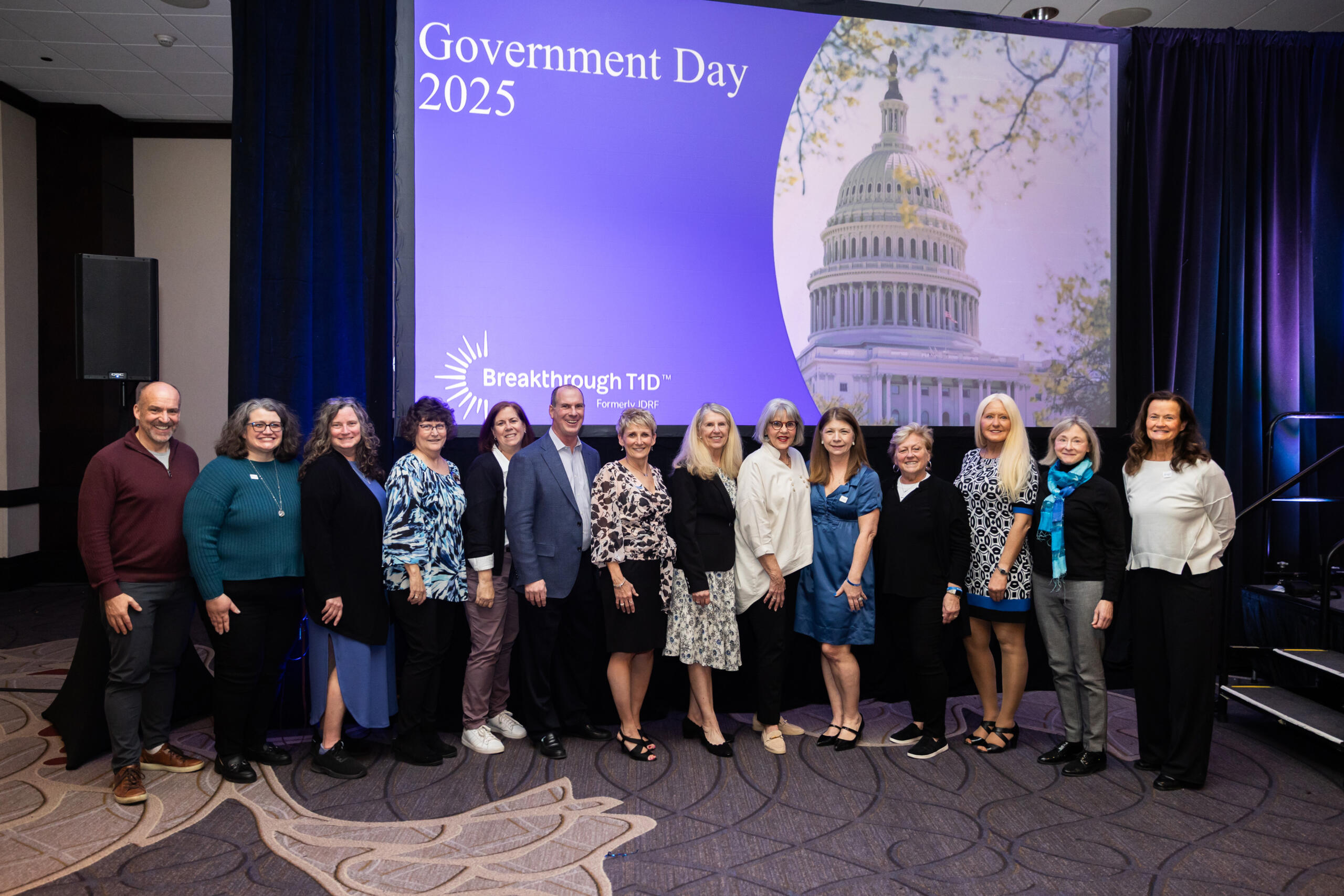
Just days after Government Day wrapped, Congress and the President enacted a six-month, $80 million renewal that funds the program through the end of September, 2025. This achievement is the result of strong bipartisan support fueled by the voices represented at Government Day, our countless advocates around the country, and the steadfast leadership of Congressional champions like Senate Diabetes Caucus co-chairs Senators Susan Collins (R-ME) and Jeanne Shaheen (D-NH), and Congressional Diabetes Caucus co-chairs Representatives Diana DeGette (D-CO) and Gus Bilirakis (R-FL).
“The Special Diabetes Program has fundamentally changed life for the 1.6 million Americans who, like me and my daughter, live with type 1 diabetes. Breakthroughs like artificial pancreas technology and beta cell replacement therapies are possible because of the Special Diabetes Program,” said Breakthrough T1D Chief Global Advocacy Officer Lynn Starr.
Support T1D Research & Cures

Our advocates delivered another key and timely message: Congress must maintain the momentum toward finding cures and ensure strong funding and staffing for essential agencies like the NIH and FDA.
Breakthrough T1D believes in having efficient government agencies and programs that serve the best interests of the American people. Taxpayer dollars should always be spent thoughtfully and purposefully, focusing on advancing the public good. But we can’t slow down the incredible momentum towards T1D cures. Our advocates urged Members of Congress to do all they can to retain key staff at leading T1D related health agencies, prevent drastic cuts to NIH research grants, and provide strong appropriations to agencies so they can deliver cures, prevention strategies, and new treatments.
Accelerate Cell Therapies
Our north star is curing T1D. If we can manufacture insulin-producing cells and safely put them inside the body to replace the cells that were lost, we’ll have cured the disease. Today, cells like these are in human clinical trials—and they’re producing insulin. Clinical trial results are very promising, and one cell therapy product is entering the final trial stage before approval. The next step is keeping cells safe in the body without using drugs that have serious side effects. Researchers are working on this in several ways, from placing them inside a protective barrier to modifying cells so they are undetected by the immune system. Project ACT (Accelerate Cell Therapies) is Breakthrough T1D’s initiative to speed up the development of cell therapies and allow us to walk away from T1D for good. In their meetings, our advocates gave a preview of Project ACT and asked that Members of Congress support policies to speed the way to cures.
A special guest
Congresswoman Kim Schrier, MD (D-WA), the only current Member of Congress with T1D and first pediatrician elected to Congress, spoke to our advocates about her personal experiences and the impact of the Special Diabetes Program on those living with T1D.
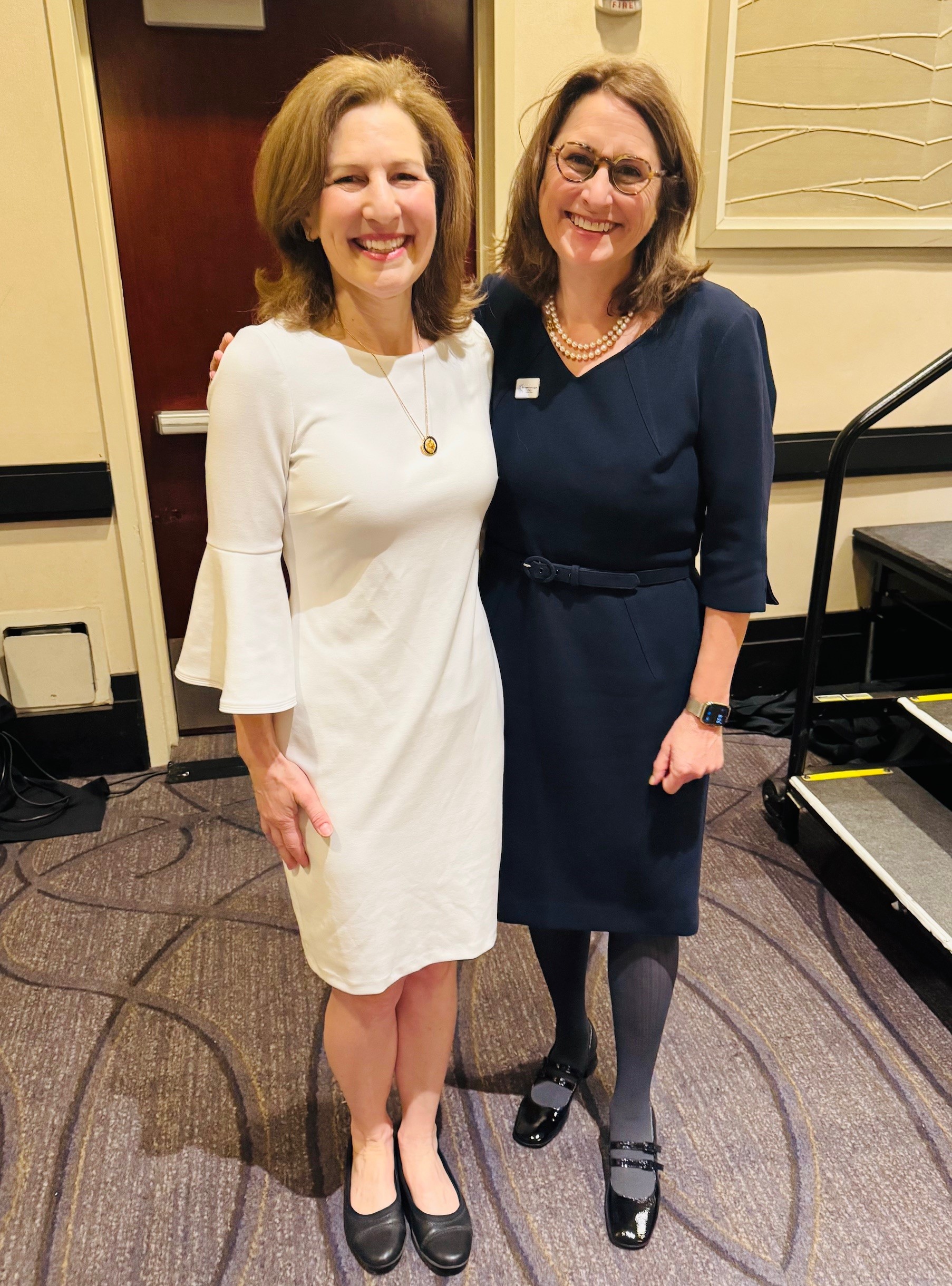
“As a doctor and a person with type 1 diabetes, I understand the challenges that come with managing this disease. That’s why I’ve worked hard in Congress to help others, including advancing legislation to improve diabetes self-management training, enhancing awareness and screening for T1D, and lowering insulin costs for millions of Americans,” said Congresswoman Schrier, M.D. “Through this advocacy, I’ve had the pleasure of working with the incredible Breakthrough T1D team. I am grateful for their dedication to research, treatment, prevention, and someday cures for this disease.”
Click here to view her full remarks.
Join us!
In just a few months, 165 youth living with type 1 diabetes will gather for Breakthrough T1D 2025 Children’s Congress—our biennial event that brings Delegates from across the country and around the world to Washington, D.C., to share their experiences with the disease, and to advocate for issues that are important to the T1D community. Until then, please join us and use your voice to help people with T1D!
Op-ed by Breakthrough T1D Chief Global Advocacy Officer Lynn Starr
In my role as Chief Global Advocacy Officer, I lead an incredibly talented and dedicated team based in Washington, D.C., to support our mission—accelerating life-changing breakthroughs to cure, prevent, and better treat type 1 diabetes (T1D) and its complications.
The Advocacy team has many functions, all in pursuit of driving our mission progress forward faster. Some examples:
- We work with regulatory agencies around the world to establish roadmaps for approvals of advanced therapies.
- We advocate for insulin affordability so anyone who needs it can access the lifesaving medication they need at a reasonable, predictable price.
- We work with insurance payers to ensure there’s coverage for treatments.
- We push for government funding for T1D research.
The team works tirelessly in pursuit of our mission—a mission that’s deeply personal to me. I’ve lived with T1D for 36 years, and my daughter was diagnosed just last year. I’ve personally benefited from the relentless work of this organization, and it’s amazing that we’ve come so far. From automated insulin delivery systems to continuous glucose monitors, the daily management of this disease today would be unrecognizable to me 36 years ago. These advances have made my life, my daughter’s life, and the lives of so many in our community so much better. But the work is not done! Life with T1D remains extremely challenging and requires constant attention and vigilance.
We know this at Breakthrough T1D, and we’re dedicated to pushing further and speeding life-changing breakthroughs. We have many tools in our toolbox as we do this work. One of our power tools is the voice of our grassroots volunteer army of advocates. They are determined champions of our cause. Our grassroots advocates amplify our policy positions on a wide range of issues. In particular, this community voice in support of U.S. government funding for T1D research through the Special Diabetes Program (SDP) has been critical.
The SDP is the U.S. Federal program created in 1997 to fund T1D research through the National Institutes of Health. It’s currently funded at $160 million annually and has contributed nearly $3.5 billion (!) to T1D research since its creation. Breakthrough T1D funds significant amounts towards T1D research ($2.5 billion to date), but we can’t do this alone. We need the SDP funding, too.
The SDP funding has had a direct hand in so many T1D advances, such as automated insulin delivery systems and the first disease-modifying therapy to delay T1D onset. These simply would not have happened without the SDP. And, with the promise of cell therapies, increased research funding is crucial.
The SDP is set to expire at the end of the year. We cannot let that happen! We’re working hard to push forward not just for an extension of the SDP, but also an increase in its funding.
Can you join our advocacy army and help us power forward? It’s incredibly simple: sign up to be an advocate and take action when we email you to ask. Just look for emails from Breakthrough T1D and click through to our action alert, where you’ll be asked to contact your Members of Congress urging support for the SDP.
That’s it—it’s really that easy. It’s also that important.
I’m honored to lead Breakthrough T1D’s advocacy efforts on behalf of the T1D community, and I am so thankful for all the support we’ve received to help drive our mission forward. Especially during National Diabetes Awareness Month, let’s make sure all our voices are heard!
In it to end it,
Lynn Starr
Chief Global Advocacy Officer
Breakthrough T1D advocacy is critical to advancing breakthroughs for the entire T1D community. With the support of our grassroots advocates, our work helps advance treatments, influence policy, and improve access to care for those worldwide who need it.
Special Diabetes Program
The Special Diabetes Program (SDP) is a critical government program that provides $150 million annually to the U.S. National Institutes of Health (NIH) exclusively for T1D research. The SDP complements Breakthrough T1D’s research funding and efforts.
To date, the SDP has dedicated nearly $3.4 billion to research. It has delivered real breakthroughs to our T1D community, including artificial pancreas systems, the first therapy to delay T1D onset, and more.
Renewing the SDP is Breakthrough T1D’s #1 advocacy priority.
Learn More About The Special Diabetes Program

“The Special Diabetes Program has provided hundreds of millions of dollars of crucial funding for a range of therapies and investigations. My son is living proof that the SDP has made a real difference in the lives of all people with T1D. But this disease doesn’t stop, so neither can we.”
Angie Platt
Breakthrough T1D Advocate and parent of Jonathan
Insulin affordability
Everyone living with T1D must have access to affordable insulin, which they need to take multiple times a day to survive. No one should suffer or die because they cannot afford insulin.
Breakthrough T1D is committed to making insulin more affordable for everyone, without stifling innovation. This goal requires effort and cooperation from all stakeholders. Government officials, insurers, employers, and others must all do their part, and we will continue to do ours: working with all of them to lower the cost of insulin.
Learn More About Insulin Access And Innovation
“Our out-of-pocket cost for insulin and diabetes supplies was significant and often forced us to make difficult choices regularly. T1D advocacy has given us a voice to tell our stories directly to our elected officials and make an impact and meaningful change for our community.”
Samantha Merwin
Breakthrough T1D Advocate and parent of Saige
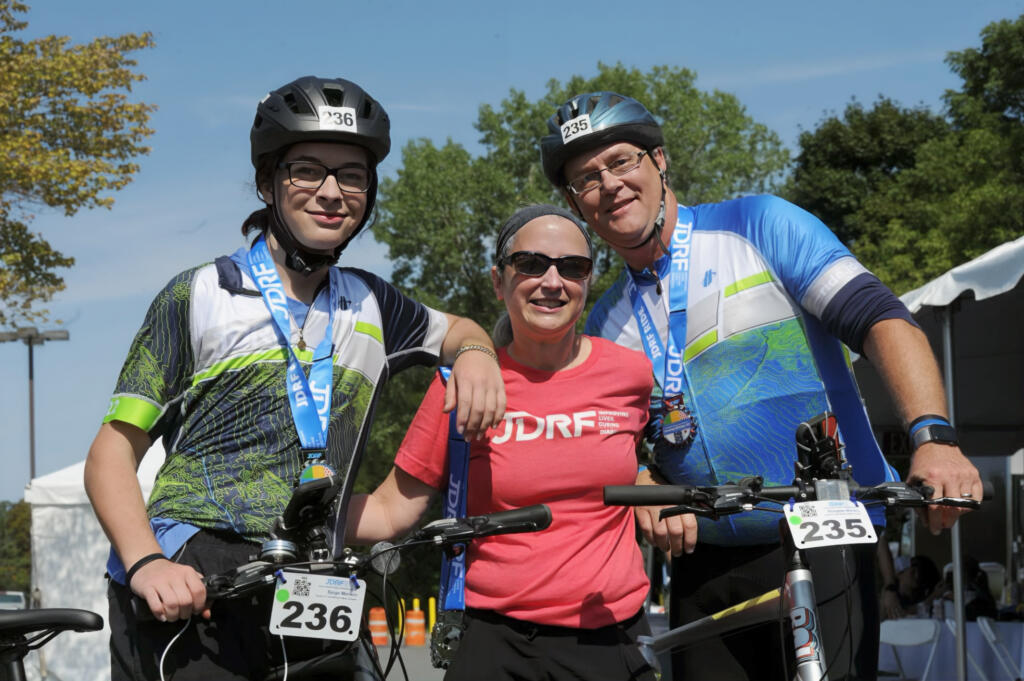
Global access
T1D is a global problem, and Breakthrough T1D is the leading international T1D research and advocacy organization.
Our work makes the global scope and impact of T1D more apparent. Spearheading projects like the T1D Index to capture worldwide T1D data and Early Detection to advance general population screening helps us shed light on the condition and connect the global community.
Improved global access to T1D therapies and care will accelerate our mission progress. By attracting new ideas and supporters, the power of Breakthrough T1D’s research, advocacy, education, and outreach extends even further and will ultimately save lives.
Learn More About Global Access
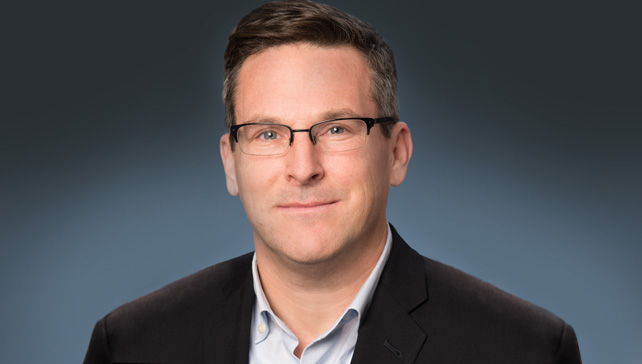
“As a member of the T1D community, I have seen first-hand the profound human, emotional, and financial burden it has on those who live with it. We have the potential to change the trajectory of T1D and improve the lives of millions of people.”
Aaron J. Kowalski, Ph.D.
Breakthrough T1D CEO
We are Breakthrough T1D
Breakthrough T1D is knocking on the door of something big. Giant leaps are happening nearly every day. You have gotten us to where we are today—and you can help us get to the finish line faster. So that you, your loved ones, and people everywhere can enjoy a world free from the burden of T1D. A world where people don’t have to manage their diabetes—don’t take insulin, don’t have blood sugar highs and lows, and don’t develop complications. With your ongoing support, we won’t stop until this condition is a thing of the past.
Learn More About Our New Brand
Learn More About Our Organization
Our organization has a new name, but at 2024 Government Day, our advocates had the same mission: Tell Congress what they must do to support the T1D Community. Luckily for Breakthrough T1D, our advocates are the best in the country and were more than up to the task.
A critical event
Without the partnership of the Federal Government, we will never achieve the ultimate breakthrough—cures for T1D. Our champions on Capitol Hill have enacted key legislation and policies that have directed billions in funding to T1D research to date and crafted policies that have made it easier for our community to manage this disease.
This year, 230 Breakthrough T1D Advocates headed to Washington, D.C., to meet with their Members of Congress and let them know what they can do now and next to continue to drive breakthroughs. All said, they conducted approximately 500 meetings!
Preparing for the Hill
Before their Congressional meetings, our advocates were treated to a full day of detailed briefings. This included seminars on the research partnership between Breakthrough T1D and the National Institutes of Health (NIH), our key messages for Members of Congress, and more.
Advocates also had the distinct pleasure of hearing from two Members of Congress.
Senator Mark Warner and Representative Brett Guthrie both took time to speak about the importance of advocacy and their commitment to working with us to cure T1D.
Introducing Breakthrough T1D
2024 Government Day coincided with our announcement that JDRF is now Breakthrough T1D. Our advocates’ first task was to reintroduce us to their Members of Congress to let them know that while our organization has a new name, we have the same mission—we continue to advocate for the millions of people affected by T1D. They also reinforced that this new name will allow us to better represent the entire T1D community, from the children and families who just received a life-changing diagnosis to the adults who have been living with T1D for decades.
Renewing the Special Diabetes Program
The next item on the agenda was renewal of the Special Diabetes Program (SDP).
The SDP is a critical Federal program that currently provides $160 million annually for T1D research through NIH. This program funds research across all stages of T1D, including prevention, treatments, and cures. It has also delivered significant results for the T1D community. Just a few examples include:
- The first FDA-approved therapy to delay T1D onset in individuals in early-stage T1D
- The development of automated insulin delivery systems, which are now standard of care of people with T1D
- Therapies for the most common T1D complications, including diabetic eye disease
The funding for this important program is set to expire on December 31, 2024, and Breakthrough T1D Advocates asked Members to enact a multi-year renewal of the SDP at $170 million annually.
Pass the INSULIN Act
Everyone who relies on insulin to survive must have access to this life-saving therapy at a predictable, affordable price. Breakthrough T1D is tackling this problem in several different ways, including by supporting the non-profit Civica to manufacture and sell insulin. Our champions on Capitol Hill are working to address this problem, too.
The INSULIN Act, a bi-partisan bill introduced by Senators Susan Collins and Jeanne Shaheen, is the legislation best suited to address this problem and the foundational issues that have created it.
Advocates called on their Members to support this bill, which would establish a $35 per month insulin co-pay cap for those with commercial insurance and take additional steps to ensure insulin is more affordable for everyone, regardless of insurance status.
You too are encouraged to contact your Members about this legislation.
Other asks
Advocates also requested strong Federal funding for NIH, the U.S. Food and Drug Administration, and the Advanced Research Projects Agency for Health.
Additionally, they asked their Members of Congress to keep Breakthrough T1D in mind as they begin to consider and weigh legislation related to cell therapies. This research, which is advancing at a prodigious rate, is no longer science fiction. Insulin-producing cells created in a laboratory have been placed into people with T1D in clinical trials—and they’re working. It’s critical that we work together now to ensure that these therapies have the smoothest possible path to commercialization.
Celebrating together
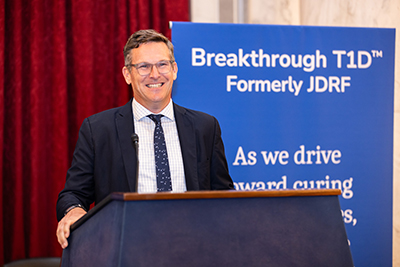
Government Day culminated in the ‘In it to End it’ Congressional Reception hosted in the historic Kennedy Caucus Room in the Russell Senate building. This event, which was kicked off by Breakthrough T1D CEO, Aaron Kowalski, Ph.D., and Chief Global Advocacy Officer, Lynn Starr, featured remarks by Senate Diabetes Caucus Co-Chairs, Senators Susan Collins and Jeanne Shaheen, and Congressional Diabetes Caucus Co-Chairs, Representatives Diana DeGette and Gus Bilirakis, was a celebration of the new brand and all the breakthroughs we have achieved together. It was also a moment to appreciate the special relationship between Breakthrough T1D and Congress and to rally together for the next step of our shared journey toward cures for T1D.
You can join too
The Advocates who traveled to Washington did an amazing job telling their stories—and we need you to tell yours, too. If you haven’t already, sign up to be an advocate today. We need your voice to ensure Congress continues to support the needs of the T1D community
Breakthrough T1D Advocacy spokesperson Natalie Stanback on Capitol Hill at the Breakthrough T1D 2023 Children’s Congress
Natalie Stanback knows type 1 diabetes (T1D), she knows advocacy, and she knows how to get things done on Capitol Hill.
When her daughter, Nadia, was diagnosed with T1D at the age of 3, it did not come out of the blue. Natalie’s brother, Michael, had been diagnosed 24 years prior. “Given my prior knowledge and experience, Nadia’s diagnosis was breathtaking but not as traumatic as it could have been,” Natalie said.
Today, Nadia is thriving and almost entirely managing her T1D on her own. She’s a champion on the soccer field, involved in her middle school’s theatre program, and “the best big sister” to her siblings. Natalie attributes her daughter’s full and healthy life to advances driven by research and advocacy.
Advocating for Progress
Natalie and her family have been active in the type 1 diabetes community for years. Their involvement with Breakthrough T1D started with One Walk and Team Breakthrough T1D. That’s also where Natalie began speaking publicly about the positive impact Breakthrough T1D makes on her family and everyone living with T1D.
Natalie entered the world of Breakthrough T1D Advocacy at the Breakthrough T1D 2019 Children’s Congress, where Nadia was a Delegate and spoke to her Members of Congress about what it’s like to live with T1D, and why Federal research funding and insulin affordability are critical. The experience made a huge impression on Natalie. “We loved the ability to do something,” she said. “It was such a tangible validation and inspiration.”
From then on, Natalie was a resounding voice in the T1D community. Good Morning America profiled the Stanback family in 2021 to raise awareness about T1D. In 2022, she briefed Congress on the real-world impact of the insulin affordability crisis. And Natalie served as Chair at the Breakthrough T1D 2023 Children’s Congress, a full-circle moment for her and her family. “Helping to foster hope and ignite the advocacy fire in others has been tremendously rewarding,” she said.
Sharing her Story with the U.S. Senate
Most recently, in December 2023, Natalie testified in front of the U.S. Senate Committee on Health, Education, Labor, and Pensions (HELP) in a hearing about diabetes in America alongside Breakthrough T1D CEO Aaron Kowalski, Ph.D. They spoke about the need for affordable insulin and the importance of renewing the Special Diabetes Program (SDP).
“The SDP has supported research that directly contributed to the development of the incredible devices Nadia relies on every day,” Natalie said to the Committee. “We need to ensure the advances made possible by this program continue.”
During the hearing, Natalie also discussed the impact T1D has on daily life. She admitted that even as a “glass half-full” family, the burden of T1D is immense. “It takes a village to raise a child,” she said. “It takes a city to raise a child with diabetes.”
Women Warriors

As a caregiver, Natalie faces her own challenges with T1D. “Burnout is real,” she said. “It’s important for me to catch the signs of it so I can manage the mental load and maintain mindfulness.”
She recognizes that women, whether they like it or not, are often the “default parent” when it comes to caring for a child with T1D. To her, that’s a perfect reason for more women to join in Breakthrough T1D’s advocacy efforts.
“Women are trailblazers,” she said. “Our footsteps are the ones our children most commonly step into first. We have an opportunity to lead them into the future we dream of.”
Sadly, Natalie’s brother passed away from T1D complications in 2020. That fueled her drive for progress and cures even more. Natalie will continue advocating for Nadia, the memory of her brother, and the entire T1D community until the condition is a thing of the past. “A better future for my daughter is why I do this,” she said. “I am so grateful that Breakthrough T1D has provided me with a platform to make it a reality.”
Learn more about how you can get involved in Breakthrough T1D Advocacy.
In the NFL, some players stand out not just for their skills on the field but for their commitment to making a positive impact beyond the game. Orlando Brown Jr., NFL Super Bowl Champion and Cincinnati Bengals offensive tackle is one such player. But it’s not just about football for Orlando; it’s also about tackling an opponent of the community and his family: type 1 diabetes (T1D).
A Personal Journey
Orlando’s connection to T1D is deeply personal. It began with his grandmother’s diagnosis. Then, unexpectedly, he lost his father, NFL Orlando Brown, Sr., to diabetic ketoacidosis, a complication of T1D. When his younger brother received a T1D diagnosis at age 11, Orlando’s determination to advocate for T1D research and education became unshakeable.
Stepping Up as an Ambassador
Orlando emphasizes that T1D’s impact on his family isn’t unique. He knows many face the same challenges – uncertainty, stigmas, and a lack of information about type 1 diabetes. However, he’s determined to use his platform to increase awareness and access to the life-changing treatments and technologies made available through Breakthrough T1D-funded research.
This year, Breakthrough T1D is excited for Orlando’s new season with the Cincinnati Bengals. We’re also thrilled about his commitment to step up as an ambassador for Breakthrough T1D, a role he has embraced with open arms. His goal? To educate people about T1D and the importance of screening, support T1D research, and use his platform to advocate for insulin affordability and policies like the Special Diabetes Program (SDP) to support the type 1 diabetes community.
Empowering Others
Orlando’s message is clear – he aims to empower those with T1D to pursue their dreams. He firmly believes that education, advocacy, and community involvement can create a world where no one faces T1D alone and one day, we can achieve our vision of a world without the disease.
Orlando’s story is one of hope and unwavering commitment to positively impacting the world. As he tackles T1D with the same dedication he brings to the gridiron, he reminds us that we can all play a part, both big and small, to reach the T1D end zone.
Learn more about Orlando and join the fight for the T1D End Zone.
Breakthrough T1D 2023 Children’s Congress is over—and it was an incredible success! It’s been a long four years since the last Breakthrough T1D Children’s Congress, and the Delegates did an incredible job of making up for lost time. Delegates forged new connections, told hundreds of stories, and, as a result, we made real progress towards achieving key aspects of our Advocacy agenda.
One Breakthrough T1D Children’s Congress, One Voice
Every two years, more than 160 children with type 1 diabetes (T1D) between the ages of 4 – 17 gather in Washington, D.C., to meet face-to-face with some of the top decision-makers in the U.S. Government. The selected Delegates represented nearly every state, as well as four International Affiliates. Delegates have a unique and empowering opportunity to help Members of Congress understand what life with type 1 diabetes is like, while forming lasting bonds with fellow youth who live with this autoimmune disease.
The event was led by Breakthrough T1D 2023 Children’s Congress Chair Natalie Stanback and her family.
The Delegates focused on two areas of BreakthroughT1D’s Advocacy Agenda: Renewing the Special Diabetes Program (SDP) and the insulin affordability crisis.
The SDP currently provides $150 million annually to T1D research through the National Institutes of Health (NIH), the country’s premier medical research agency. Additionally, it complements Breakthrough T1D’s research efforts, allowing Breakthrough T1D and the NIH to collaborate to advance T1D research as quickly as possible. The SDP is set to expire in September and renewing it is Breakthrough T1D’s biggest priority—and the #1 job for the Delegates.
Right now, there is legislation to renew the SDP for two years at $170 million annually. This would be the first annual increase in funding in 20 years.
“The SDP is vital,” said Natalie Stanback. “By spreading awareness in the halls of Congress and meeting with our lawmakers, we did all we could to ensure the research made possible by this program continues. We made sure the needs of the T1D community were heard!”
Congress also must build on recent progress made, and further address the high cost of insulin in America. More must be done to ensure all those who need it have access to affordable insulin.
Over the course of three days, Delegates traveled to Washington D.C., spent time with each other, and received training on how to advocate for these issues with their Members of Congress.
Celebrity T1D Role Models Join the Fight in Washington
Ten T1D champions also supported the event, inspiring the Delegates and joining our fight for the T1D community. These celebrity Role Models, who all either have T1D or a direction connection to it, included:
- Breakthrough T1D 2019 Children’s Congress Delegate, Athlete, and American Ninja Warrior Women’s Champion – Katie Bone
- NFL Super Bowl Champion – Orlando Brown, Jr.
- Broadcast Journalist – Madison Carter
- Rendering & Dailies Supervisor, Pixar Animation Studios “Turning Red” – Susan Fong
- Saxophonist & Music Arranger – Antoine Gibson
- Producer, Songwriter, Rock & Roll Hall of Famer – Jimmy Jam
- Breakthrough T1D Chief Executive Officer – Aaron J Kowalski, Ph.D.
- International Supermodel – Stephanie “Bambi” Northwood-Blyth
- Senior NFL Insider at ESPN, Sports Broadcast Journalist – Adam Schefter
- Actor & Producer – Derek Theler
In addition to lending their voices to the cause on Capitol Hill, the T1D Role Models participated in a town hall. At this event, the Delegates had the opportunity to ask questions and interact with the T1D Role Models. The questions varied, from “How does T1D impact working on a movie set?” to “What is it like to win American Ninja Warrior with T1D?” The T1D Role Models answered every question with honesty and specificity—showing that anything is possible for people affected by this disease.
Delegates Take on Capitol Hill
On July 11th, the Delegates officially headed to Capitol Hill.
The first event was a Senate Appropriations Committee hearing led by U.S. Senators Patty Murray (D-WA) and Susan Collins (R-ME), Chair and Vice Chair of the Senate Appropriations Committee, as well as Senator Jeanne Shaheen (D-NH), a senior member of the Appropriations Committee, the hearing was titled “Accelerating Breakthroughs: How the Special Diabetes Program Is Creating Hope for those Living with Type 1 Diabetes.”
Five witnesses spoke about the importance of these issues and what it’s like to live with T1D.
During the hearing, these witnesses testified before a standing room-only chamber full of our Delegates and their families. Delegates Elise Cataldo (NH) and Maria Muayad (ME) testified bout what it’s like to live with T1D, including the literal highs and lows, and the importance of the SDP and insulin affordability. Griffin Rodgers, MD, Director, National Institute of Diabetes and Digestive and Kidney Diseases, provided his perspective on the SDP, what it has accomplished, and what it can do with more, sustained funding. James “Jimmy Jam” Harris, award-winning Music Producer and Philanthropist, told his story of life as a T1D dad and his dreams for a world without T1D. Breakthrough T1D CEO Aaron Kowalski, Ph.D. also testified, sharing his unique perspective as a scientist and person with T1D.
Attendance was fantastic; 15 Senators came to the hearing and asked questions. This hearing was a unique and positive one—featuring a lot of applause and consensus amongst all the Senators.
“I got a sense that there was true bipartisanship in that room,” said Jimmy Jam after the hearing.
At the conclusion of the hearing, the Delegates traveled across Capitol Hill to meet with their Senators and Representatives to reiterate our calls to action: renew the SDP and enact legislation to make insulin more affordable.
Additionally, several Delegates who participated in T1D clinical trials traveled to the Food and Drug Administration (FDA) to meet with FDA Commissioner Robert M. Califf, M.D., and FDA staff to share their experiences in clinical trials and discuss the importance of developing and approving new therapies for the T1D community.
It’s A Wrap
In total, 163 Delegates, plus our T1D Role Models, conducted 239 meetings with U.S. Senators and Representatives to gain support for these critical issues. They did an incredible job—and were ideal representatives of the T1D Community. These Delegates were tasked with telling their stories about life with T1D, and each of them rose to the occasion—and more.
Get Engaged!
You can experience the highlights of Breakthrough T1D 2023 Children’s Congress on our social media channels, including interviews with Delegates and celebrities, recaps from Breakthrough T1D CEO Aaron Kowalski, and more. Check them out on Instagram, X, Facebook, YouTube and LinkedIn.
You can also experience navigating Capitol Hill virtually in Breakthrough T1D One World! The game, created by Breakthrough T1D as part of the Breakthrough T1D Game2Give program, is a virtual world built inside the popular online game Roblox that allows for education, celebration, and of course—play! It’s a place where people in the Breakthrough T1D community—kids, teens, and adults—can get together, play games, learn about T1D, and meet new friends. In the most recent update, players can take on the role of a Breakthrough T1D 2023 Children’s Congress Delegate and visit Capitol Hill, run obstacle courses, and so much more. Learn more and play at https://www.roblox.com/games/5823990610/Breakthrough-T1D-World
Join Us!
While the Delegates did an amazing job advocating to our legislators to renew the SDP and do more to fix the insulin affordability crisis, you can join the fight too. Sign up to be an advocate! It’s the easiest way to stay up-to-date and take action on advocacy issues.
This event was made possible by:
Delegate Social Sponsors Dexcom, Vertex, and Xeris Pharmaceuticals
Supporting Sponsors Insulet and Lilly
Diamond One Society Partnership Sponsors Ford and Marshalls
Cynthia Rice, Breakthrough T1D’s Chief Mission Strategy Officer, will leave behind quite a legacy once she steps down from her role at Breakthrough T1D at the end of March 2023.
“In her time with Breakthrough T1D, she has led with strategic purpose and passion,” read Breakthrough T1D CEO Aaron Kowalski’s December 2022 memo announcing Cynthia’s decision to leave. “She has been an incredibly valuable partner to me, as well as staff and volunteers throughout the organization.”
During her tenure at Breakthrough T1D, she has helped bring the artificial pancreas project to life, has driven efforts to renew the Special Diabetes Program, and was a key player in Breakthrough T1D’s response to and handling of COVID-19—all with the partnership of our strategic staff and vast network of volunteers, who are the bedrock of our advocacy efforts.
“It’s possible—while challenging—to impact the research and development (R&D) ecosystem to improve options and outcomes for people living with chronic diseases like type 1 diabetes,” says Cynthia. “Defining goals, tapping into strengths, building capacities, and remaining determined in the face of obstacles are critical.”
And for nearly two decades, she has done just that at Breakthrough T1D.
“Leverage—enlisting others to our cause—is critical to our success and core to our organizational DNA, whether it’s engaging friends and families, company R&D heads, government officials, or foundation leaders,” Cynthia says.
The Artificial Pancreas Endeavor
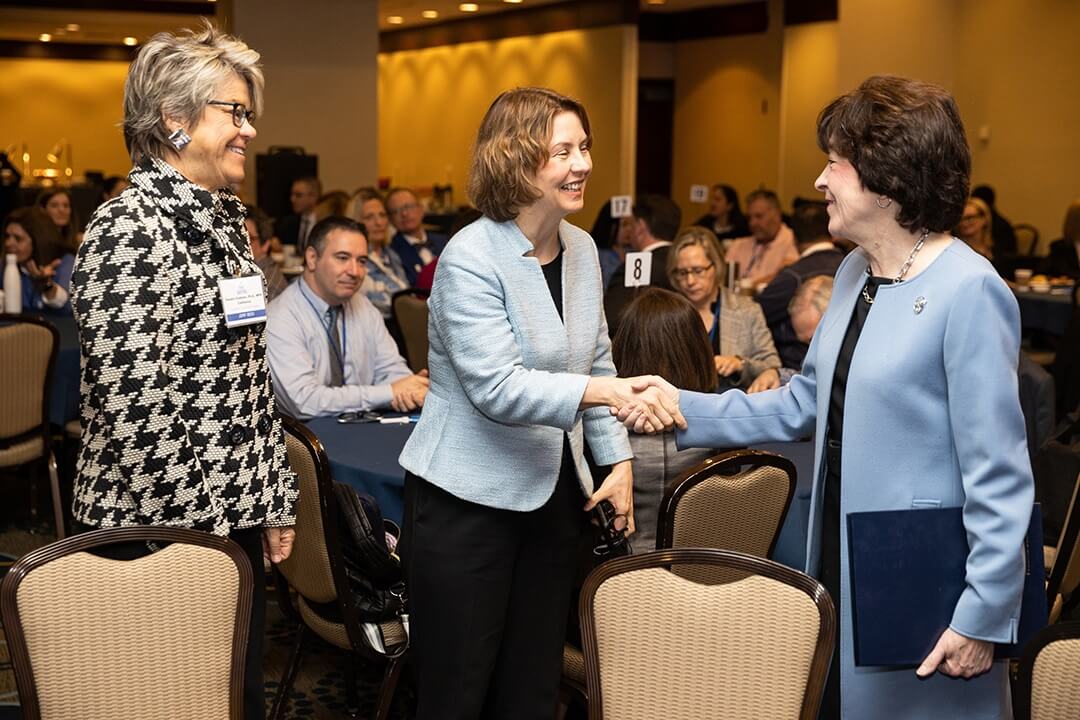
From Left: Breakthrough T1D International Board of Directors member Claudia Graham, Ph.D., M.P.H.; Breakthrough T1D Chief Mission Strategy Officer Cynthia Rice; and Senator Susan Collins (R-ME). Left-click on image to slightly enlarge.
Cynthia came to Breakthrough T1D in September 2005. Real-time continuous glucose monitors (CGMs) were in the early stages of development, with one approved just months prior.
Aaron Kowalski, Ph.D., who had come to Breakthrough T1D a year before and is now the CEO, and Jeffrey Brewer, a member of Breakthrough T1D’s International Board of Directors at the time, had just spent six months interviewing academic scientists, corporate executives, and other like-minded players to figure out whether Breakthrough T1D wanted to take on the development of an artificial pancreas. There were many barriers, and companies were very wary of getting involved.
In the interviews, it became clear that despite the hesitation among companies, there was significant potential benefit for the T1D community in pursuing artificial pancreas technologies. The leadership—needed to foster a therapy roadmap, research funding, regulatory pathway, and health care access—just wasn’t there.
Breakthrough T1D changed that. We made it a priority, bringing not only our research funding, but also our powerful advocacy forces, to speed the development of these devices.
“The goal of multiple artificial pancreas systems, with ongoing innovation, drove our strategy,” says Cynthia, “and we took actions early on with that goal in mind, utilizing our strengths, building new capacities and relationships, and battling doggedly to overcome obstacles.”
Overcoming the Obstacles
Among the first obstacles was that the benefits of continuous glucose monitoring in the management of T1D had only been shown in small studies. In 2008, a Breakthrough T1D multi-site randomized control clinical trial showed that people with T1D who used the devices experienced significant improvement in blood-sugar control. This was instrumental to CGM coverage and laying the groundwork for the artificial pancreas system to come to fruition and be covered by the healthcare system.
Another obstacle was linking together the two main components of a closed-loop artificial pancreas system—the glucose sensor and an insulin pump. Breakthrough T1D established the Artificial Pancreas Consortium, which connected researchers from several different laboratories to develop the computer algorithms so that the machines could “talk” to each other and then be commercialized, as necessary.
A third obstacle—perhaps the most challenging of them all—required engaging government, regulatory, and health care groups.
Breakthrough T1D worked with researchers, insurance companies, the National Institutes of Health (NIH), the U.S. Food and Drug Administration (FDA), Medicare, and Congress on regulatory and coverage issues. When the first artificial pancreas system came on the market in 2016, the T1D community was more than ready for the life-changing T1D management it offered.
“Seeing the artificial pancreas go from concept to reality, which is helping so many people keep their blood-sugar management in control, is what makes Breakthrough T1D and all of the advocacy volunteers—who sent an email, made a call, signed an action alert, or met with their Member of Congress—very proud of this historic achievement and the impact that these will have on the individual lives of those with type 1 diabetes,” Cynthia adds.
The Special Diabetes Program (SDP)
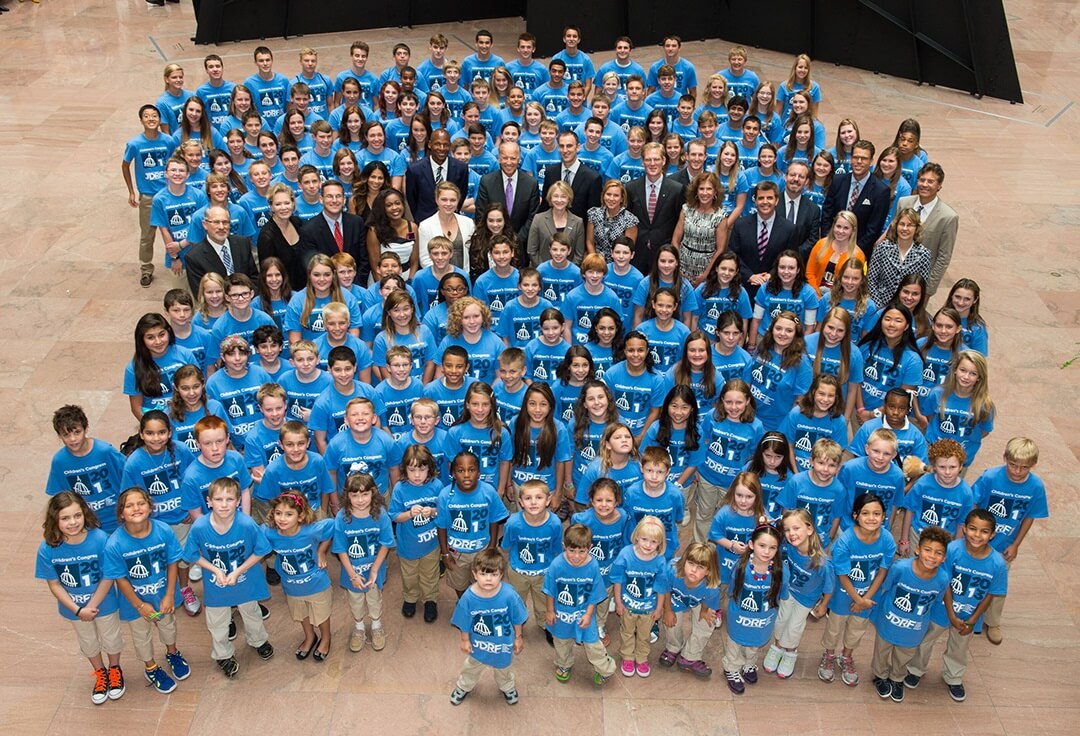
Cynthia Rice (far right, fifth row from the back), Breakthrough T1D volunteers, and Delegates at Children’s Congress 2013 with then-Vice President of the United States Joseph R. Biden (center). Left-click on image to slightly enlarge.
In 1997, with the bipartisan leadership of White House Chief of Staff Erskine Bowles and Speaker Newt Gingrich, Congress created the Special Diabetes Program (SDP), which annually allocates $150 million for T1D research at the NIH. Breakthrough T1D is the chief advocate of the SDP.
The SDP has been instrumental to some of the greatest advancements in the history of T1D—including research that led to artificial pancreas systems and the recent FDA approval of the first-ever drug that can delay onset of T1D, Tzield™ (teplizumab-mzwv).
Since its inception, the SDP has invested $3.4 billion into T1D research. The program’s success and continued renewal is the result in part of hundreds of Breakthrough T1D advocates meeting with their Members of Congress each year to discuss the importance of the SDP.
“Sustaining bipartisan support to renew again and again in challenging times in Washington is thanks to the amazing volunteer-staff partnership in advocacy,” says Cynthia. “This is now paying enormous dividends, not only in the artificial pancreas systems, but in cures therapies, including disease-modifying and cell therapy treatments.”
Breakthrough T1D’s Unique Strengths
“Breakthrough T1D has two strengths that are rare,” says Cynthia. “The first is scientific expertise, convening the best and brightest across fields and generating ideas to solve the biggest problems. The second is community passion, to influence R&D priorities, regulatory pathways, and health care access and enlist government leaders to take action for our cause.”
She adds: “Breakthrough T1D has harnessed these strengths and organized the community, leading to our higher-level power: Influence.”
“It’s not only possible but realizable for a small band of determined people, starting with our founding moms, to tackle and overcome big obstacles,” says Cynthia. “As long as we organize ourselves well, deploy smart strategies, and develop an advocacy message that people can get around, Breakthrough T1D will continue to have the impact that has historically been the pillar of our advocacy work.”
“More broadly, strong patient advocacy strengthens our health system and our society and helps align incentives in research, development, and health policy to benefit the people affected by the disease,” says Cynthia. “All of us as leaders should be thinking about what else we can do to help strong, independent patient communities come together and thrive as advocates, which I hope to do when I return to the health sector in 2024 after a sabbatical.”
A Legacy of Women Leaders
Breakthrough T1D was founded by women, has mostly women staff and volunteers, and counts numerous successful and influential women among its current and past leaders and supporters.
Women who, like Cynthia Rice, share Breakthrough T1D’s vision for a world without T1D and who will stop at nothing to turn that vision into reality.
“From the majority staff and volunteer base, to our women founders, to our international chair Mary Tyler Moore, to our advocates, fundraisers, and scientists,” says Cynthia, “Breakthrough T1D, as an organization, shows the power women can have to impact their world.”
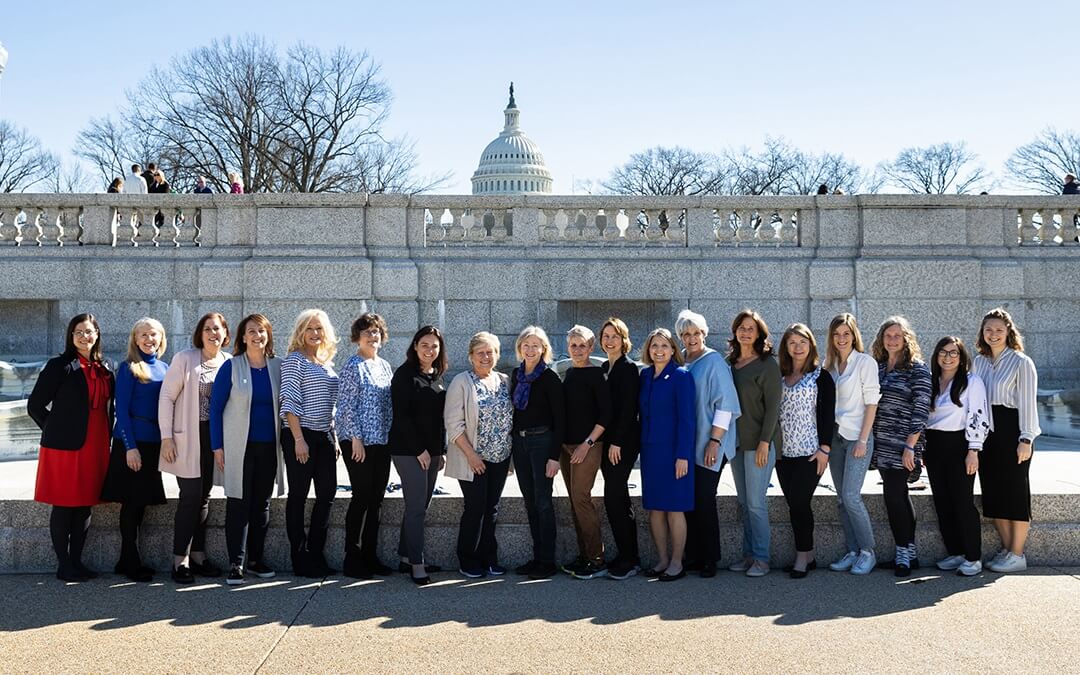
Members of Breakthrough T1D’s Grassroots Leadership Team (GLT) along with members of Breakthrough T1D’s Advocacy Team, including Cynthia Rice (ninth person in from the right) at Breakthrough T1D Government Day 2023. Left-click on image to slightly enlarge.
The Federal Government is one of Breakthrough T1D’s most important partners in advancing research to better treat, prevent, and ultimately cure type 1 diabetes (T1D). Breakthrough T1D’s annual Government Day event, held in Washington, D.C., brings together dedicated Breakthrough T1D Advocates from around the nation to use their own personal stories to communicate the financial, medical, and emotional costs of T1D to our nation’s leaders—and to tell them what they can do to help. Of course, we also carve out time for networking, volunteer recognition, and key updates on research and advocacy priorities.
After several years of conducting meetings virtually because of the pandemic, this year, Breakthrough T1D advocates held approximately 475 in-person meetings with Senators, Representatives, and their staffs to highlight the issues affecting the T1D community. We’re pleased to share that they arrived in DC filled with purpose, and departed after making a huge impact on Capitol Hill.
This year, Breakthrough T1D advocates enlisted Congressional engagement in the following priorities:
Renewing the Special Diabetes Program
The Special Diabetes Program (SDP) is a critical Federal program that provides $150 million annually for T1D research through the National Institutes of Health (NIH). This program has been instrumental in nearly all the recent T1D advances, including work towards cures and improvements in therapies.
However, this funding expires September 30, 2023 so we are working to renew the program to continue making progress in these and other areas such as environmental triggers, immune therapies, glucose control, and T1D-related complications. Learn more here.
Achieving Insulin Affordability
Our foundational belief is that everyone should have access to the insulin they need to survive. Together, Breakthrough T1D staff and volunteers have been raising our voices on this issue for years, engaging with Congress, health plans, manufacturers, etc., and we’ve seen recent progress—including manufacturers lowering insulin prices and the $35 insulin co-pay cap for people on Medicare included in the Inflation Reduction Act last year. These are steps in the right direction made possible because of your advocacy—but there is more to do. We are calling on Congress to extend the co-pay cap to all Americans and to enact systemic reforms so insulin is more affordable for all who need it. Learn more here.
Mary Tyler Moore Award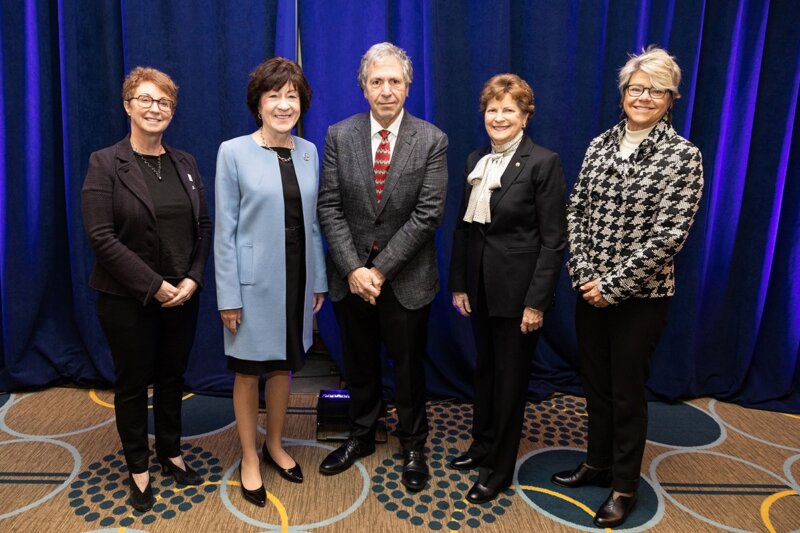
Breakthrough T1D also recognized three distinguished female Congressional leaders who have been instrumental in the fight against T1D during Breakthrough T1D’s annual Government Day. The inaugural Mary Tyler Moore Award was presented to U.S. Senators Jeanne Shaheen (D-NH) and Susan Collins (R-ME), co-chairs of the Senate Diabetes Caucus, and U.S. Representative Diane DeGette (D-CO), co-chair of the Congressional Diabetes Caucus. Breakthrough T1D recognized these influential leaders for their longstanding support of the T1D community, in honor of Mary Tyler Moore, a television pioneer, and advocate who served as Breakthrough T1D’s international chair for more than 30 years and helped to increase Congressional funding for research advancements through the NIH and the SDP.
We are proud of the work that Breakthrough T1D advocacy volunteers are doing both locally and nationally, and we are grateful for our legislative partners who are pushing for progress in Congress and beyond. Together, we are building a future without T1D.
There’s a lot of work left to be done—and we need your help! If you’re not already, please sign up to a Breakthrough T1D advocate to help secure Federal funding for important diabetes research, inform health and regulatory policy, and improve the quality of life for those affected by T1D until we find cures.
